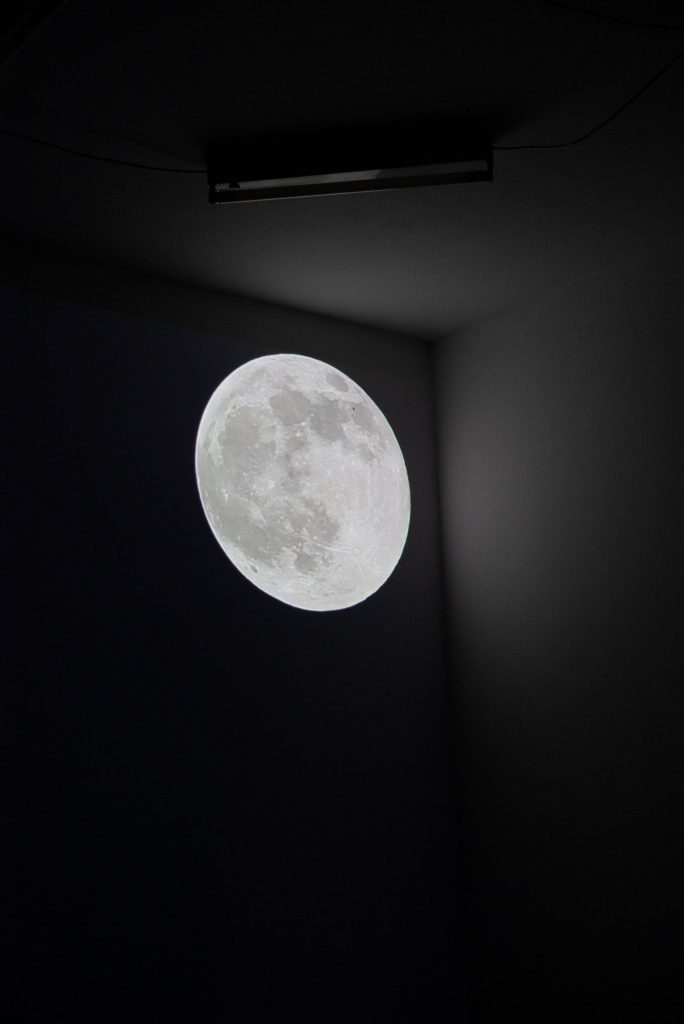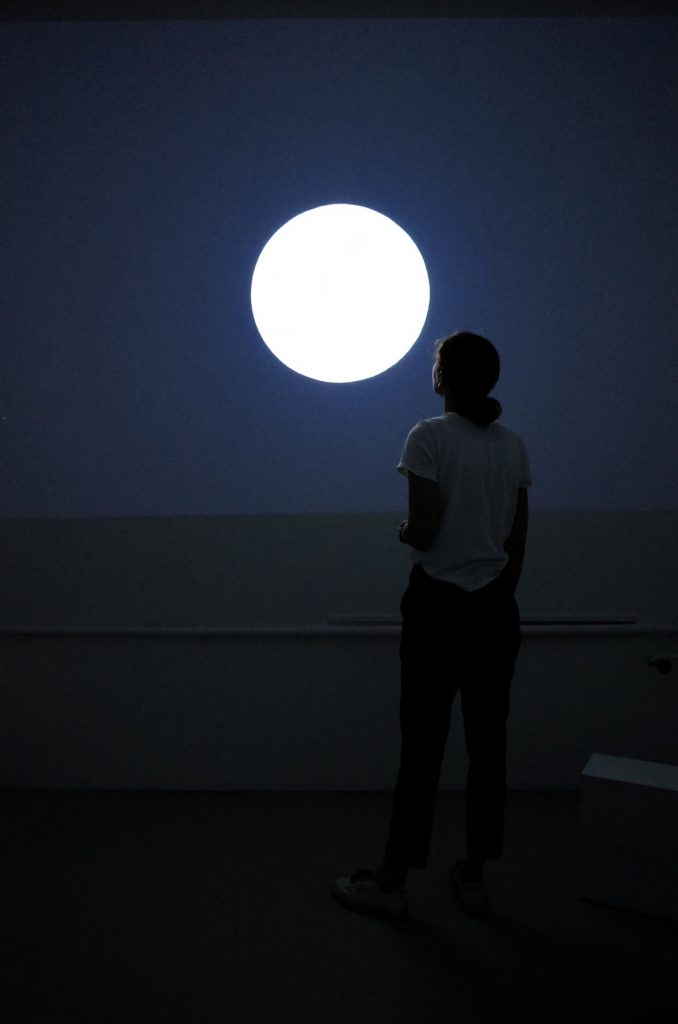
14 Minuten, 52 Sekunden. So lange benötigt der Mond, um von einem Ende der Ausstellungswand zum anderen zu gelangen. Für Mond, durch Bild wandernd hat Meuresch den Vollmond mit statischer Kamera gefilmt. Sein langsamer, fast nur am Bildrand wahrnehmbarer Gang entspricht in der Realität einer Geschwindigkeit von etwa einem Kilometer pro Sekunde. Was bei längerem Betrachten auffällt, ist das gleichbleibende Aussehen des Mondes. Das Phänomen ist schnell erklärt: Da der Mond für das Umkreisen der Erde genauso viel Zeit benötigt wie für das Rotieren um die eigene Achse, wendet er uns immer dieselbe Seite zu. Sein Kreisen um die Erde entspricht damit der Bewegung einer Fotografin, die um ihr Modell kreist, um es von allen Seiten aus zu fotografieren. In der Nacht, könnte man sagen, macht uns der Mond alle zu Stars.
//
14 minutes, 52 seconds. That is how long it takes the moon to travel from one end of the exhibition wall to the other. For Mond, durch Bild wandernd, Meuresch filmed the full moon with a static camera. Its slow walk, perceptible almost only at the edge of the image, corresponds in reality to a speed of about one kilometer per second. What is noticeable when viewing it for a longer time is the constant appearance of the moon. The phenomenon is easily explained: Since the moon needs the same amount of time to circle the earth as it does to rotate around its own axis, it always turns the same side towards us. Its circling around the Earth thus corresponds to the movement of a photographer who circles around her model in order to photograph it from all sides. At night, one could say, the moon turns us all into stars.


Während sich in dem projizierten Bild nur der Mond bewegt, ist es in Doppelmond allein die Kamera, die für Bewegung sorgt. In jedem der vier Teile inszeniert Meuresch ein anderes Spiel: Sie bewegt den Mond mal schnell, mal langsam, zoomt hinein und wieder hinaus, lässt ihn verschwinden und wieder auftauchen. Dabei scheint sich der Mond immer wieder von einer anderen Seite zu zeigen: Schien er eben noch so elastisch wie ein Gummiball, wirkt er jetzt so zerbrechlich wie eine Lampe. Zeigt er sich links als Kraterlandschaft, ist er rechts nur ein einsamer Punkt im Weltall. In gewisser Hinsicht ist Doppelmond ein Spiel mit der Kamera unter veränderten Vorzeichen: Gemeint ist hier nicht das expressive Posieren vor der Kamera, sondern ein Spiel hinter der Kamera, das dem regungslosen Gesicht des Mondes immer wieder neuen Ausdruck verleiht.
Die Arbeit Mond (Wasser) beantwortet die Frage, wer oder was für Bewegung sorgt, noch einmal anders. Die sichtbare Bewegung geht hier nicht von der Kamera aus und zumindest vordergründig auch nicht vom Mond. In Bewegung ist hier allein das Medium, in dem sich das Mondlicht noch einmal spiegelt. Tatsächlich ist das quecksilberne Leuchten der Wasseroberfläche das Ergebnis einer doppelten, gewissermaßen kreisförmigen Reflexion: Im Rücken der Erde strahlt die Sonne, der Mond lenkt das Licht in Richtung Erde und das Wasser wirft es zurück an den Himmel. Dabei verleiht die fließende Bewegung dem Licht etwas seltsam Lebendiges und zugleich Unwirkliches. Als wäre der Mond, reflektiert in einem Element der Erde, nicht mehr Teil von dieser Welt.
//
While only the moon moves in the projected image, in Doppelmond it is the camera alone that provides movement. In each of the four parts, Meuresch stages a different game: sometimes she moves the moon quickly, sometimes slowly, zooms in and out again, makes it disappear and reappear. In doing so, the moon always seems to show itself from a different side: if it seemed as elastic as a rubber ball a moment ago, it now appears as fragile as a lamp. On the left it appears as a crater landscape, on the right it is just a lonely point in space. In a certain sense, Doppelmond is playing with the camera under different auspices: What is meant here is not expressive posing in front of the camera, but rather playing behind the camera, which repeatedly gives new expressions to the motionless face of the moon.
The work Mond (Wasser) answers the question of who or what provides movement in yet another way. The visible movement here does not come from the camera and, at least at first glance, not from the moon. The only thing in motion here is the medium in which the moonlight is reflected. In fact, the mercurial glow of the water surface is the result of a double, in a sense circular reflection: the sun shines behind the earth, the moon directs the light towards the earth, and the water reflects it back to the sky. In this process, the flowing movement gives the light something strangely alive and at the same time unreal. As if the moon, reflected in an element of the earth, is no longer part of this world.


Für Astrid (Doppel) hat Meuresch ein Modell mit zwei leicht versetzten Kameras gefilmt und Anweisungen zu unterschiedlichen Posen gegeben. Im Kontext der Ausstellung irritiert die Arbeit auf besondere Weise. Das Objekt der Betrachtung ist hier kein gesichtsloser Gegenstand, sondern ein Mensch, der zu uns zurückschaut. Durch die Verdoppelung der Perspektive entsteht eine ganz eigene Logik des Blicks: Während wir uns in jedem Augenblick entscheiden können, ob wir nach links oder rechts schauen, ob wir dem Blick des Modells ausweichen oder ob wir ihn suchen, scheint Astrid immer beides zugleich zu tun. Auch wenn sie nicht zu uns schaut, sieht sie uns an. Während der Titel der Ausstellung als Anspielung auf Rilkes „wachsende Ringe“ gelesen werden kann, erinnert Astrid (Doppel) an einen anderen Vers des Dichters: „denn da ist keine Stelle, / die dich nicht sieht. Du mußt dein Leben ändern.“
//
For Astrid (Doppel), Meuresch filmed a model with two slightly offset cameras and gave instructions for different poses. In the context of the exhibition, the work is irritating in a special way. The object of observation here is not a faceless object, but a human being looking back at us. The doubling of perspective creates a very unique logic of seeing: While we can decide at any moment whether to look to the left or to the right, whether to avoid the model’s look or to seek it, Astrid always seems to do both at the same time. Even when she is not looking at us, she is looking at us. While the title of the exhibition can be read as an allusion to Rilke’s „wachsende Ringe,“ Astrid (Doppel) recalls another famous verse by the poet: „for there is no part of it / that does not see you. You must change your life.“



Schaum 1 und 2 sind die einzigen Standbilder der Ausstellung. Als Fotografien sind sie selbst bewegungslos, aber das, was sie zeigen, ist Bewegung in Reinform. Die beiden Fotografien erscheinen damit als eine Art Gegenstück zu Mond, durch Bild wandernd. Ging es dort um eine Unveränderlichkeit in der Bewegung des Kreisens, geht es hier um das Festhalten von etwas, das schon im nächsten Augenblick unwiederbringlich verloren ist. Anders als auf den Mond schauen wir nie zweimal hinaus auf das gleiche Meer.
//
Schaum 1 and 2 are the only still images in the exhibition. As photographs, they are themselves motionless, but what they show is movement in its purest form. The two photographs thus appear as a kind of counterpart to Mond, durch Bild wandernd. Whereas there it was a matter of an unchangingness in the movement of circling, here it is a matter of capturing something that is irretrievably lost in the very next moment. Unlike the moon, we never look out twice at the same sea.


text: Clemens Espenlaub
photos: Friedrich Herz, Sophie Meuresch, Clemens Espenlaub
